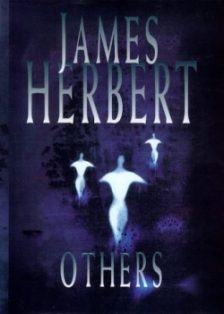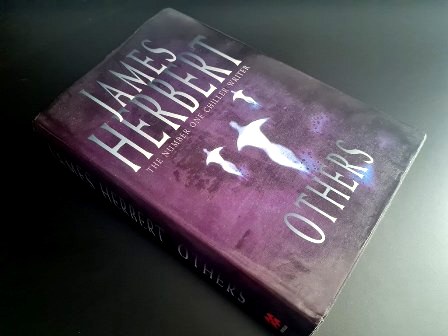
First published back in October of 1999, James Herbert’s novel ‘Others’ was a greatly anticipated return to the horror genre for this highly acclaimed author, following the triumphant release three years earlier of his post-apocalyptic action-fest ‘’48’ (1996).
DLS Synopsis:
It all begins in hell, where he is offered the chance to redeem himself. He may start again with a new life without the knowledge of his past crimes, or indeed the test for which he’s about to embark upon. If he fails, then he will be left to spend eternity in hell’s damnation. If however he has changed his ways, then heaven will await his eternal soul. He accepts the test.
Nicholas Dismas is a self-employed Private Investigator with a small team working for him within his firm. He is also physically deformed, with malformed features, a spinal curvature resulting in a dramatic hump, a withered right leg, extensive body hair (although it is somewhat sparse on his head) and only one eye. All in all, Dismas’ appearance is one that regularly draws stares and occasional hurtful comments such as the terms ‘Monster’ or ‘Freak’.
When recently widowed Shelly Ripstone hires Dismas to find her missing child who was born some eighteen years ago, Dismas is put up against one of the toughest challenges of career to date. Ripstone’s child was taken from her at birth, under the guise of a problematic birth that led to the child’s death. However, after contacting the spiritual medium Louise Broomfield, Ripstone is informed that the child is still alive and is psychically reaching out for his mother. Dismas is more than a little sceptical, but is happy to take the job to its undoubted conclusion for the high fees being paid.
His investigations lead him to a mysteriously located luxurious nursing home named Perfect Rest, where Ripstone’s midwife at the time of the birth now resides. There Dismas is introduced to the nursing home’s owner - Dr Wisbeech, whose set up and impressive medical background seems to be a little out of place for the running of a simple nursing home. When Dismas’s investigations begin to unearth a dark and twisted secret that lies at the heart of Perfect Rest and the Doctor’s disturbing research, his world quickly comes crashing down around him. For those behind the conspiracy will do anything to keep their secret away from prying eyes – murder being no exception.
Dismas will be pushed mentally, physically and psychically to rip the blanket off the twisted secret behind Perfect Rest and Shelly Ripstone’s missing child. The conspiracy is far darker and more threatening than Dismas ever would have foreseen. For behind closed doors reside the ‘others’...
DLS Review:
Written in the first-person-perspective of Nicholas Dismas (aka Dis), the storytelling itself is often of a comical and refreshingly down-to-earth nature. Physical deformity plays a major role within the plot’s premise, bringing together a very personal journey for our narrator and principal protagonist. Quite quickly, an empathetic bridge is formed between reader and narrator, with much warmth of character built upon at every possible opportunity.
The pace is a gradual affair, which at first trudges along with the mysterious circumstances that surround Ripstone’s missing child and the bizarre atmosphere of Perfect Rest. However, once Herbert kicks in with the first vicious (and truly shocking) murder (along with Dismas’s subsequent retaliation), the pace gains momentum with each turn of the page.
The majority of the tale appears to be of a principally supernatural nature. That is, until the final third of the novel kicks in; pouncing on the storyline with a new action-packed and uncompromising plot that catapults the tale all the way to the conclusion. Elements of Clive Barker’s early novel ‘Cabal’ (1988), Katherine Dunn’s ‘Geek Love’ (1989), or indeed Frank Henenlotter’s film ‘Basket Case 3: The Progeny’ (1992) come spilling out from everywhere.
The character of Nicholas Dismas is an incredibly likeable character to have narrating the tale. His anti-hero aspects bring out a gritty realism to the character which stands out as a great contrast with the otherwise bizarre nature of the predominantly supernatural tale. The inclusion of a love interest for Dismas creates an interesting sub-story, bringing out a whole new array of complex emotions for Dismas to contend with.
The finale is certainly momentous, particularly in proportion to the overall length of the novel - taking up a good quarter of the book’s length. However, this action-packed (and lengthy) showdown is as intense as it is thrilling, with one jaw-dropping revelation after the next building up to a crescendo of freakish discoveries.
The ultimate concluding passage wraps the whole novel up with the bookending format, taking the reader back to the very first chapter to draw the whole tale tightly together.
All in all, the novel is a gripping and intriguing journey that unveils a litany of truly shocking revelations. Herbert signs the novel off with an ‘End Note’ stating that the story is in fact based on a true incident that occurred in a certain London children’s hospital some years ago. More shockingly still, Herbert insists that most of the ‘others’ described within the novel are taken from actual historical medical cases. A final note to leave the reader feeling shocked and disturbed...
The novel runs for a total of 504 pages.
© DLS Reviews










